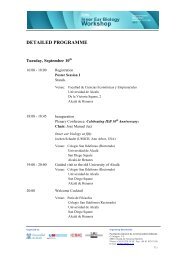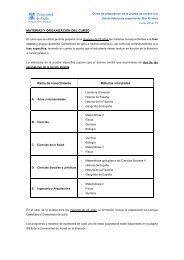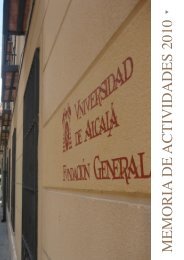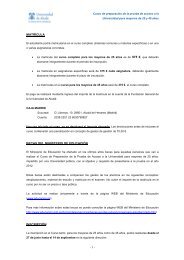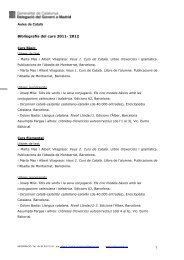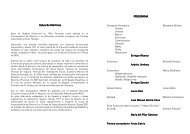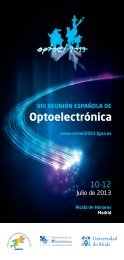Memoria 2009 - Fundación General de la Universidad de Alcalá
Memoria 2009 - Fundación General de la Universidad de Alcalá
Memoria 2009 - Fundación General de la Universidad de Alcalá
You also want an ePaper? Increase the reach of your titles
YUMPU automatically turns print PDFs into web optimized ePapers that Google loves.
FUNDACIÓN GENERAL DE LA UNIVERSIDAD DE ALCALÁ / MEMORIA <strong>2009</strong><br />
FUNDACIÓN GENERAL DE LA UNIVERSIDAD DE ALCALÁ / MEMORIA <strong>2009</strong><br />
Comunicación <strong>de</strong> Resultados presentados hasta ahora como consecuencia<br />
<strong>de</strong>l estUdio:<br />
1. Lopez Rubio, Jacob I, Ruiz P, Almeria R, B<strong>la</strong>zquez R, Perez Calvo C, Burgaleta<br />
C. Deteccion automatizada <strong>de</strong> eritrob<strong>la</strong>stos. Comparacion Del Sysmex XE 2100,<br />
Cell- Din saohire y microscopia óptica. XLVIII Reunión Nacional <strong>de</strong> <strong>la</strong> AEHH y XXII<br />
Congreso <strong>de</strong> <strong>la</strong> SETH. Haematologica 2006;91 (Ext 2):54.<br />
2.<br />
3.<br />
4.<br />
López Rubio M, Magro E, Pascual T, Garcia Suárez J, Gil Fernan<strong>de</strong>z JJ, Calero<br />
MA, Martín Guerrero Y, Perez Calvo C, Burgaleta C. Accuracy of p<strong>la</strong>telet counting<br />
by haematology analysers and its potential impact on the transfusion <strong>de</strong>cisionmaking<br />
process.14 th Congress of the European Hematology Association. Berlin,<br />
June 4-7, <strong>2009</strong>. Hematologica <strong>2009</strong>;94(s2): 316<br />
López Rubio M, Magro E, Pascual T, Garcia Suárez J, Gil Fernan<strong>de</strong>z JJ, Calero MA,<br />
Martín Guerrero Y, Burgaleta C. Recuento <strong>de</strong> p<strong>la</strong>quetas por distintas tecnologías<br />
y su implicación en <strong>la</strong> <strong>de</strong>cisión <strong>de</strong> transfusión <strong>de</strong> p<strong>la</strong>quetas en pacientes con trombocitopenia<br />
severa.LI Reunión nacional <strong>de</strong> <strong>la</strong> AEHH y XXV Congreso Nacional <strong>de</strong> <strong>la</strong><br />
SETH. Haematologica <strong>2009</strong>;94(Ext 2):132<br />
H. Magro, J. J. Gil-Fernán<strong>de</strong>z, J. García-Suárez, M. Callejas, Y. Martín, T Pascual,<br />
M. López-Rubio. Comparative effect of filgrastrim vs. pegfilgrastrim after chemotherapy<br />
on high gra<strong>de</strong> non Hodgkin lymphoma.14 h Annual meeting European<br />
Haematologya association.Hematologica <strong>2009</strong>;94(s2 (Berlin <strong>2009</strong>).<br />
2.- ALMA BANDA 7<br />
Desarrollo y fabricación <strong>de</strong> amplificadores criogénicos para equipar<br />
los receptores <strong>de</strong> <strong>la</strong> Banda 7 <strong>de</strong>l interferómetro ALMA (Atacama Large<br />
Millimeter Array) 1 .<br />
El proyecto ALMA se <strong>de</strong>sarrol<strong>la</strong> en dos fases: pre-producción y producción.<br />
La primera consiste en fabricar y equipar 8 <strong>de</strong> <strong>la</strong>s 50 antenas<br />
<strong>de</strong> <strong>la</strong>s que constaba inicialmente el interferómetro (posteriormente<br />
se incorporaron 16 antenas japonesas). La pre-producción <strong>de</strong><br />
los amplificadores <strong>de</strong> <strong>la</strong> Banda 7 se realizó mediante un contrato<br />
entre FGUA (OAN) y ESO (junio <strong>de</strong> 2005) para el <strong>de</strong>sarrollo <strong>de</strong> 10 prototipos<br />
y fabricación <strong>de</strong> 32 unida<strong>de</strong>s <strong>de</strong> pre-producción <strong>de</strong> los amplificadores,<br />
y un subcontrato entre FGUA y <strong>la</strong> empresa Tecnologías<br />
<strong>de</strong> <strong>la</strong>s Telecomunicaciones y <strong>de</strong> <strong>la</strong> Información (TTI) para fabricar<br />
29 <strong>de</strong> esas 32 unida<strong>de</strong>s (los prototipos y restantes unida<strong>de</strong>s <strong>de</strong> preproducción<br />
se hicieron en el CDT). Esta fase está terminada y todos<br />
los amplificadores entregados.<br />
El proyecto ALMA está ahora en su fase <strong>de</strong> Producción en lo que se refiere a los amplificadores<br />
<strong>de</strong> <strong>la</strong> Banda 7.<br />
3.- ALMA BANDA 9<br />
- 100 -<br />
PROYECTOS REALIZADOS EN COLABORACIÓN CON EL INS-<br />
TITUTO GEOGRÁFICO NACIONAL<br />
1.- AGENCIA ESPACIAL<br />
Desarrollo y fabricación <strong>de</strong> amplificadores criogénicos para equipar los receptores<br />
<strong>de</strong> <strong>la</strong> Banda 9 <strong>de</strong>l interferómetro ALMA (Atacama Large Millimeter Array).<br />
Durante <strong>2009</strong> se entregaron 30 <strong>de</strong> los 100 amplificadores previstos en el contrato<br />
(unida<strong>de</strong>s número 67 a 96), todas el<strong>la</strong>s fabricadas en el Centro <strong>de</strong> Desarrollos Tecnológicos<br />
(ver ilustración).<br />
- 101 -<br />
Contrato con el European Space Operations Centre (ESOC), <strong>de</strong> <strong>la</strong> Agencia Espacial<br />
Europea (ESA), para mejorar <strong>la</strong> tecnología existente en Europa <strong>de</strong> dispositivos semiconductores<br />
<strong>de</strong> fosfuro <strong>de</strong> Indio (InP) y fabricar una serie <strong>de</strong> dispositivos HEMT<br />
InP para amplificadores criogénicos. Dicha investigación se realiza en co<strong>la</strong>boración<br />
con el Laboratorio <strong>de</strong> Campos Electromagnéticos y Electrónica <strong>de</strong><br />
Microondas <strong>de</strong>l Instituto Fe<strong>de</strong>ral <strong>de</strong> Tecnología <strong>de</strong> Zurich (ETHZ), en<br />
Suiza.<br />
Esta actividad es continuación <strong>de</strong> <strong>la</strong> <strong>de</strong>sarrol<strong>la</strong>da entre 2004 y 2006.<br />
En esta ocasión se trata <strong>de</strong> perfeccionar <strong>la</strong> tecnología puesta a punto<br />
en el período 2004-2006 y exten<strong>de</strong>r<strong>la</strong> a <strong>la</strong> fabricación <strong>de</strong> transistores<br />
en una banda <strong>de</strong> frecuencias más alta (Ka, entre 25,5 y 32.3 GHz).<br />
A<strong>de</strong>más <strong>de</strong> un mínimo <strong>de</strong> 100 transistores optimizados para funcionar<br />
a temperaturas criogénicas <strong>de</strong>ntro <strong>de</strong> esa banda, se prevé fabricar<br />
4 amplificadores <strong>de</strong> <strong>de</strong>mostración <strong>de</strong> sus prestaciones.<br />
4.- PROYECTO SKADS<br />
En octubre <strong>de</strong> <strong>2009</strong> se recibieron los primeros transistores fabricados<br />
con éxito por ETHZ. Estos transistores adoptan una gran variedad<br />
<strong>de</strong> configuraciones con objeto <strong>de</strong> po<strong>de</strong>r elegir entre el<strong>la</strong>s <strong>la</strong>s que<br />
<strong>de</strong>n mejores prestaciones. Se han hecho algunas medidas <strong>de</strong> ruido<br />
con transistores montados en amplificadores a 6 GHz y a 22 GHz,<br />
obteniéndose resultados muy prometedores. Se está en fase <strong>de</strong> análisis<br />
<strong>de</strong> estos resultados para seleccionar <strong>de</strong> entre todas <strong>la</strong>s configuraciones<br />
recibidas aquel<strong>la</strong>s con mejores características <strong>de</strong> ruido<br />
y centrarse en <strong>la</strong> mejora <strong>de</strong> <strong>la</strong>s mismas durante <strong>la</strong> siguiente fase <strong>de</strong>l<br />
proyecto.<br />
Durante el año <strong>2009</strong> se han seleccionado los diseños <strong>de</strong>finitivos <strong>de</strong>l prototipo <strong>de</strong> amplificador<br />
diferencial <strong>de</strong> bajo ruido, <strong>la</strong> antena y <strong>la</strong> red <strong>de</strong> alimentación <strong>de</strong> un array <strong>de</strong><br />
antenas en el rango <strong>de</strong> frecuencias <strong>de</strong> 300 Mhz a 1 GHz y doble po<strong>la</strong>rización. Basándose<br />
en estos prototipos se ha realizado el diseño completo <strong>de</strong>l array, en el que se<br />
incluye <strong>la</strong> integración <strong>de</strong> todos ellos en un único sistema <strong>de</strong> 1m 2 <strong>de</strong> área total (FIDA3:<br />
FG-IGN Differential Active Antenna Array).<br />
1- ALMA es un proyecto conjunto entre EEUU, Canadá, Japón y Europa para construir el mayor interferómetro<br />
<strong>de</strong> ondas milimétricas <strong>de</strong>l mundo, que se está empezando a insta<strong>la</strong>r en el <strong>de</strong>sierto <strong>de</strong> Atacama (An<strong>de</strong>s<br />
chilenos). La parte europea <strong>de</strong> ALMA es gestionada por <strong>la</strong> Organización Europea para <strong>la</strong> Investigación<br />
Astronómica en el Hemisferio Sur (ESO).<br />
PROYECTOS DE INVESTIGACIÓN<br />
PROYECTOS DE INVESTIGACIÓN



